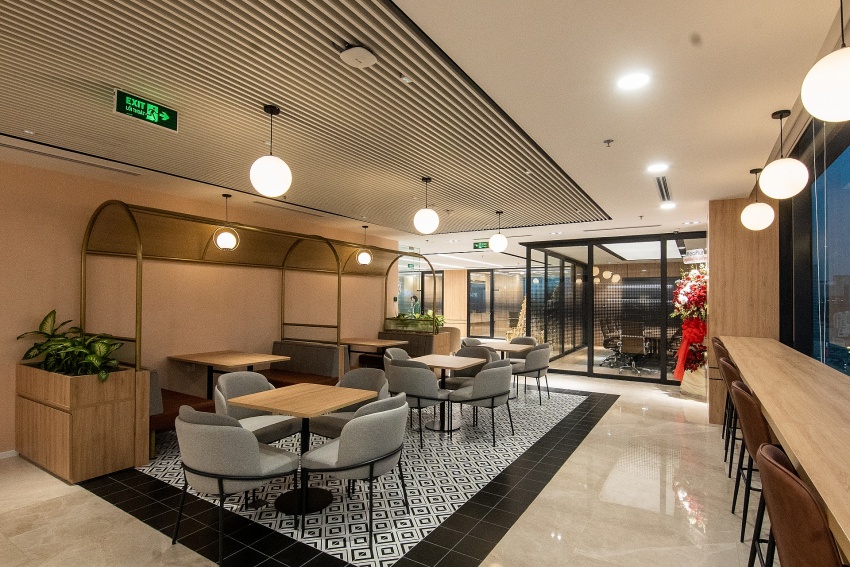Unpacking hybrid workplace trends
 |
| Tu Thi Hong An, director of Commercial Leasing at Savills Ho Chi Minh City |
Could you please tell us about the differences between the hybrid office model and flexible office solutions?
Flexible office space includes serviced offices, managed offices, shared offices, and co-working spaces. Meanwhile, a hybrid office is an arrangement in which a company's managers and employees sometimes work together in a physical office and sometimes remotely. The idea is to provide the best of both worlds for workers and employers.
Often with flexible solutions, many companies share the same floor, space, and utilities. As such, tenants save on costs. They can use the space and the facilities comfortably without restriction. However, such shared offices are limited in terms of the businesses that can use them. They are mostly used by startups and small companies with a minimal and flexible number of employees. Other suitable tenants for this model come from the IT industry and other, project-based companies.
However, the shared model cannot be applied to large companies and corporations with long-standing company cultures. When a certain number of employees is exceeded, the rental cost would be too expensive. Therefore, companies need to evaluate their hybrid solutions carefully.
The hybrid office model is still transforming. The model comes with changes in design and new habits, as well as a different corporate governance method. Employees will have the choice of either working in the office, at home, or in any other place outside the office while still ensuring work efficiency, with companies aiming for the same services, workflow, and management methods. The model should be backed by IT that supports remote working. Generally, the type of business will determine the kind of hybrid model which that company could apply.
For instance, companies can apply an online or offline working ratio flexibly: 50-50, 70-30, or they can simply follow a schedule that meets their needs.
What is the demand for the application of hybrid offices in Vietnam?
People are still hesitant and do not see the need to change. Through the recent lockdowns, they have seen many changes in the way they work, and many companies had to adapt. Once a company is used to this way of working, it will be easier to implement long-term hybrid solutions. Hybrid offices ensure business continuity and offer employees the opportunity to balance their lives and choose a workplace to their liking.
This model will also help companies save costs. For example, when a company grows and hires more employees, it would normally have to rent more office space. But with the hybrid model, more space may not be necessary.
| |
| Hybrid office at Savills in Ho Chi Minh City. |
So what are the driving factors for the transition to a hybrid office model?
Firstly, the office supply in large cities is limited, especially in Ho Chi Minh City. In the last two years, the market has not had any outstanding projects for office leasing. As such, it is not easy for expanding companies to find offices that meet their growing needs. The model, if applied, will help them stay in the same place without having to expand their space or rent additional offices elsewhere and it is more economical for companies.
Second, the catalyst that makes the hybrid model more interesting for companies is social distancing amid the pandemic. In Ho Chi Minh City, the lockdown has been quite long, and the time was enough for companies to change the way they work. Otherwise, operations would have been seriously affected.
What issues should companies pay attention to when transitioning to a hybrid model?
The issue that needs the most attention is the technology infrastructure to support the transition to a hybrid office, including the administrative management and supporting equipment for remote working, which must be standardised to ensure an efficient hybrid model.
In short, the transition to hybrid offices is a natural trend and will undoubtedly take place. The model can be applied in many industries and different-sized companies as long as it maintains companies' core values.
What the stars mean:
★ Poor ★ ★ Promising ★★★ Good ★★★★ Very good ★★★★★ Exceptional
Related Contents
Latest News
More News
- JustCo expands business into Vietnam (December 22, 2025 | 17:58)
- Sun Group breaks ground on $2 billion Van Don casino complex (December 19, 2025 | 18:14)
- Rare, beautiful, sustainable: the mark of iconic real estate (December 19, 2025 | 08:00)
- Owner-occupied housing stabilises, paving the way for new growth cycle (December 18, 2025 | 17:04)
- Unlocking urban potential of smart cities (December 18, 2025 | 16:50)
- Green finance offers 'passport' for Vietnamese construction, building materials firms (December 15, 2025 | 08:00)
- Gamuda Land commit long-term investment (December 12, 2025 | 11:49)
- HITC ties up with Evolution to develop AI and hyperscale data centres in Vietnam (December 11, 2025 | 12:09)
- Real estate deals boom via high-profile names (December 08, 2025 | 11:32)
- Industrial segment shaped by M&As (December 08, 2025 | 08:00)


 Tag:
Tag:























 Mobile Version
Mobile Version